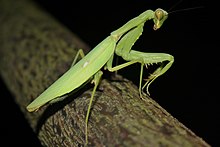| Hierodula | |
|---|---|

| |
| unidentified Hierodula species | |
| Scientific classification | |
| Domain: | Eukaryota |
| Kingdom: | Animalia |
| Phylum: | Arthropoda |
| Class: | Insecta |
| Order: | Mantodea |
| Family: | Mantidae |
| Tribe: | Hierodulini |
| Genus: | Hierodula Burmeister, 1838 |
| Species | |
| Synonyms | |
| |
Hierodula[1] is a genus of praying mantids in the tribe Hierodulini, found throughout Asia. Many species are referred to by the common name giant Asian mantis because of their large size compared to other mantids. Their large size and vibrant coloration make Hierodula mantids popular in the pet trade. Some widespread species include H. membranacea and H. patellifera;[2] however this has been considered a 'catch all' genus and is currently subject to review. In 2020, three species were moved to a new genus, Titanodula.[3]
Species[edit]


- Hierodula ansusana
- Hierodula aruana
- Hierodula assamensis
- Hierodula atrocoxata
- Hierodula beieri
- Hierodula bhamoana
- Hierodula biaka
- Hierodula borneana
- Hierodula brunnea
- Hierodula chamoana
- Hierodula chinensis
- Hierodula coarctata
- Hierodula confusa
- Hierodula crassa
- Hierodula cuchingina
- Hierodula dolichoptera
- Hierodula doveri
- Hierodula dyaka
- Hierodula everetti
- Hierodula fumipennis
- Hierodula fuscescens
- Hierodula gigliotosi
- Hierodula gracilicollis
- Hierodula harpyia
- Hierodula heinrichi
- Hierodula inconspicua
- Hierodula ingens
- Hierodula italii
- Hierodula jobina
- Hierodula kapaurana
- Hierodula laevicollis
- Hierodula lamasonga
- Hierodula latipennis
- Hierodula longedentata
- Hierodula macrodentata
- Hierodula macrostigmata
- Hierodula maculata
- Hierodula maculisternum
- Hierodula major
- Hierodula majuscula
- Hierodula malaccana
- Hierodula malaya
- Hierodula membranacea (giant Asian mantis, Sri Lanka mantis, green mantis)
- Hierodula microdon
- Hierodula mindanensis
- Hierodula modesta
- Hierodula monochroa
- Hierodula multispinulosa
- Hierodula nicobarica
- Hierodula obiensis
- Hierodula obtusata
- Hierodula oraea
- Hierodula ovata
- Hierodula papua
- Hierodula parviceps
- Hierodula patellifera (giant Asian mantis)
- Hierodula perakana
- Hierodula philippina
- Hierodula pistillinota
- Hierodula prosternalis
- Hierodula pulchra
- Hierodula pulchripes
- Hierodula purpurescens
- Hierodula pustulifera
- Hierodula pygmaea
- Hierodula quadridens
- Hierodula quadripunctata
- Hierodula quinquecallosa
- Hierodula quinquepatellata
- Hierodula rajah
- Hierodula ralumina
- Hierodula robusta
- Hierodula rufomaculata
- Hierodula rufopatellata
- Hierodula salomonis (jade mantis)
- Hierodula samangensis
- Hierodula sarsinorum
- Hierodula saussurei
- Hierodula schultzei
- Hierodula scutata
- Hierodula simbangana
- Hierodula similis
- Hierodula siporana
- Hierodula sorongana
- Hierodula sternosticta
- Hierodula stigmata
- Hierodula striata
- Hierodula striatipes
- Hierodula szentivanyi
- Hierodula tenuidentata (giant Asian mantis)
- Hierodula tenuis
- Hierodula timorensis
- Hierodula togiana
- Hierodula tonkinensis
- Hierodula tornica
- Hierodula transcaucasica
- Hierodula trimacula
- Hierodula unimaculata
- Hierodula venosa
- Hierodula ventralis
- Hierodula versicolor
- Hierodula vitreoides
- Hierodula werneri
- Hierodula westwoodi
See also[edit]
Picture[edit]
-
Hierodula, printed on the stamp of Indonesia.
References[edit]
External links[edit]
- Pictures on Up Close with Nature blog
 Media related to Hierodula at Wikimedia Commons
Media related to Hierodula at Wikimedia Commons



Well, that’s interesting to know that Psilotum nudum are known as whisk ferns. Psilotum nudum is the commoner species of the two. While the P. flaccidum is a rare species and is found in the tropical islands. Both the species are usually epiphytic in habit and grow upon tree ferns. These species may also be terrestrial and grow in humus or in the crevices of the rocks.
View the detailed Guide of Psilotum nudum: Detailed Study Of Psilotum Nudum (Whisk Fern), Classification, Anatomy, Reproduction